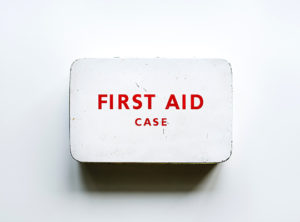
Consider this all too real scenario: it’s a Monday morning, your home is bustling with activity as everyone is getting ready to start their day. Suddenly, the house begins to shake.
You feel the vibrations under your feet as you hear plates crashing to the floor from their cabinets, the sound of wood splitting and windows shattering. Just as quickly as it began, the thunderous roar stops, replaced by a scream heard from across the house. You sprint to find your child laying on the floor, tightly gripping his bloodstained arm next to a broken glass window.
Even if you don’t find yourself living in an area necessarily prone to earthquakes, there are many natural disasters or various scenarios that could separate you and your family from higher medical care. It doesn’t take much to completely overwhelm the emergency response network in times of widespread emergencies, and even less to knock out the infrastructure we rely on to access medical services such as 9-1-1 and hospitals. Water main breaks and subsequent flooding can make main thoroughfares impassible and severe traffic from evacuees fleeing can jam roadways beyond use.
These scenarios can be seen before and after almost every natural disaster. The unfortunate reality is that you may not have access to hospitals nor your local first-responder network. The realization and adequate preparation for this possibility will ensure that you and your family are prepared to mitigate emergencies that arise until the regional infrastructure is restored.
Let’s go back to the scenario above; you pull your child’s hand away from his arm to find a three-inch laceration (cut) which is rhythmically spurting blood. As you try to recall where the family first-aid kit is, you remember it’s since devolved to a mere collection of different sized band-aids and ointments. Cuts which strike an artery (the body’s pressurized blood delivery channels) often bleed severely. A single drop of blood typically takes about 60 seconds to circulate the entire body and end up where it started, so if a large section of an artery is severed, the average human can bleed to death in two to three minutes.
Most home first-aid kits are built to manage small cuts, bumps, and bruises; not life-threatening emergencies nor prolonged wound care. In this article I’m going to provide some pointers for assembling your own home first-aid kit which will be better equipped to manage emergencies when you’re separated from higher medical care. Please keep in mind, having a well-stocked first-aid kit is one thing, but having the knowledge required to use it is another.
Your level of medical training (whether formal or self-taught) should ultimately dictate what you put into a home first aid kit, as the tools are useless without the knowledge to properly utilize them. That being said, this list contains many items which can be used in numerous ways to fit a variety of injuries/scenarios. These items (with the requisite knowledge of use) provide a good foundation for a family first-aid kit capable of addressing major life-threats and wound-care in the out-of-hospital environment:
For Life Threats
• Tourniquet (CAT or SOF; *beware of cheap fakes, they are known to bend or snap their windlass when used*) (x1)
• CPR Mask / Face Shield (x1)
• Trauma Pad (x1)
• Burn Dressing (x1)
• ABD Pads (x4)
• 3” Roller Gauze (x2)
• 1” Roller Gauze (x2)
-Rolled Kerlix (x2)
• 2” ACE Elastic Bandage (x2) **can be used to make a pressure bandage**
• 4×4 Gauze Pads (x10)
• Occlusive Dressing/Chest Seal (x1) **to seal sucking chest / neck wounds**
• Foil Emergency Blanket (x1)
For Wound Care
• Triangle Bandage (x2)
• Sam Splint (x1)
• Irrigation Saline (250ml)
• 60ml Irrigation Syringe
• Assorted Band-Aids (various sizes)
• Triple Antibiotic Ointment (x1 Tube)
• Telfa Non-Stick Dressing (x4)
• Hypoallergenic Tape (x1)
• Benzalkonium Chloride Wipes (x10)
• Benzoin Tincture (x1 bottle)
• Assorted sizes 3M Steri-Strips (x3 packs)
Miscellaneous Items
• Fine-Point Tweezers (x1 pair)
• Permanent Marker (x1)
• Gloves (x5 pair)
• Pen Light (x1)
The proper use of these items requires knowledge from both prehospital and hospital treatment modalities. While I won’t get into the details of how to, for example, seal a sucking chest wound, or utilize a pressure dressing to control severe bleeding, these materials should provide the basic foundation for mitigating wounds and emergencies that you might encounter at home or when separated from higher medical care.